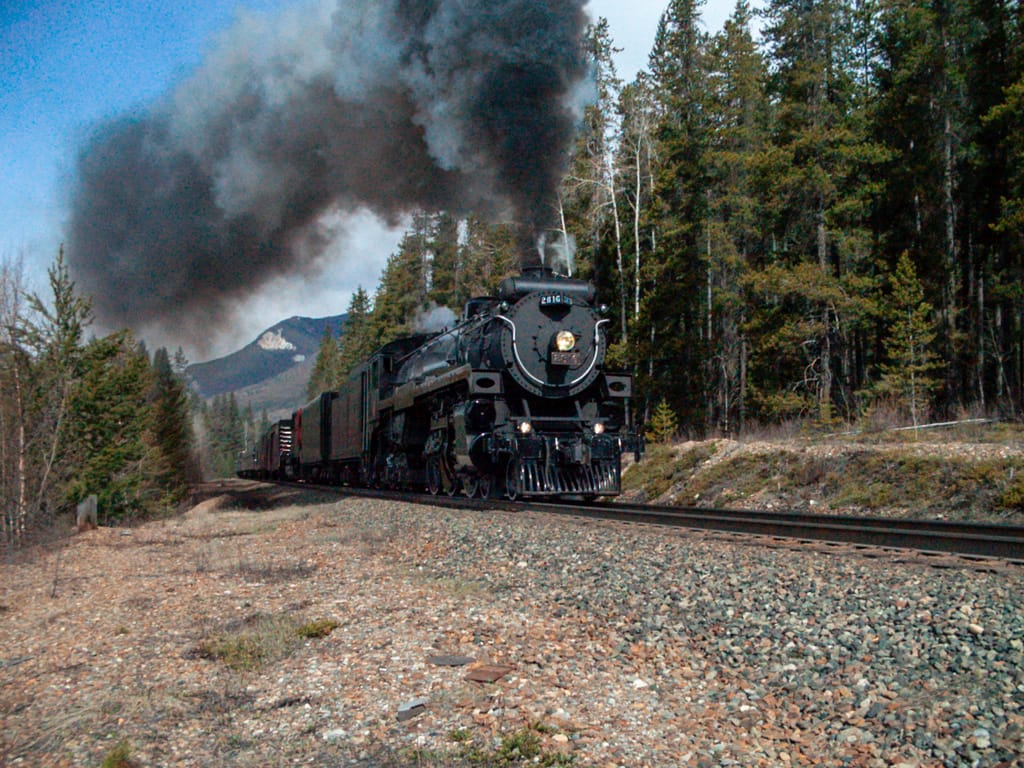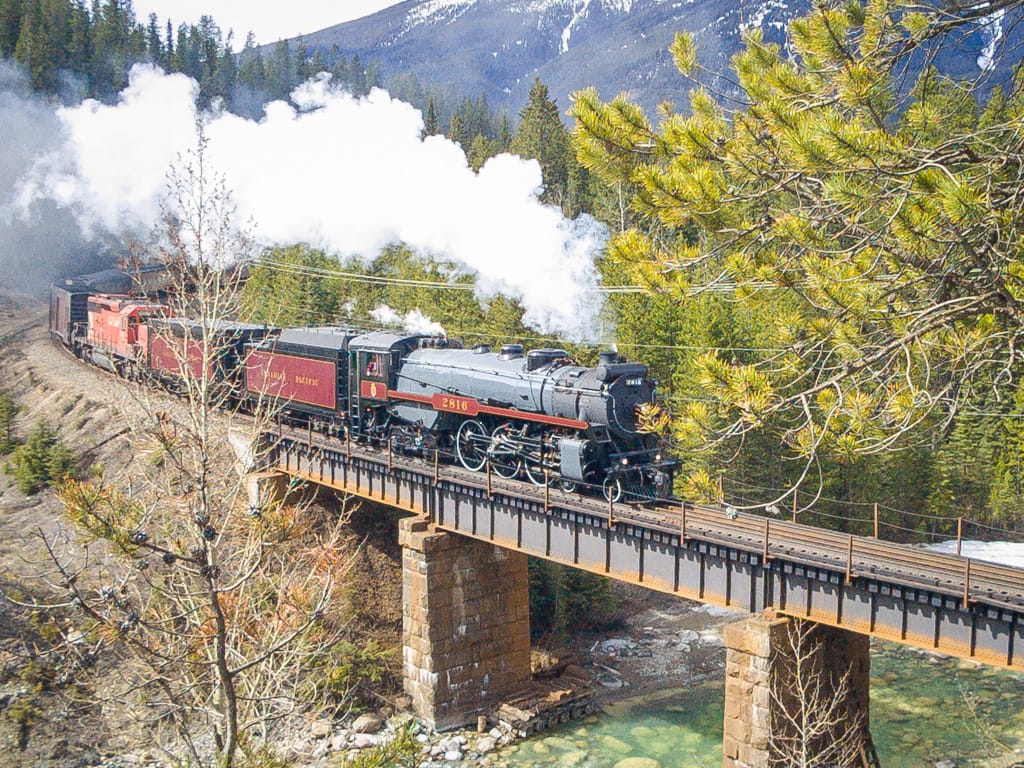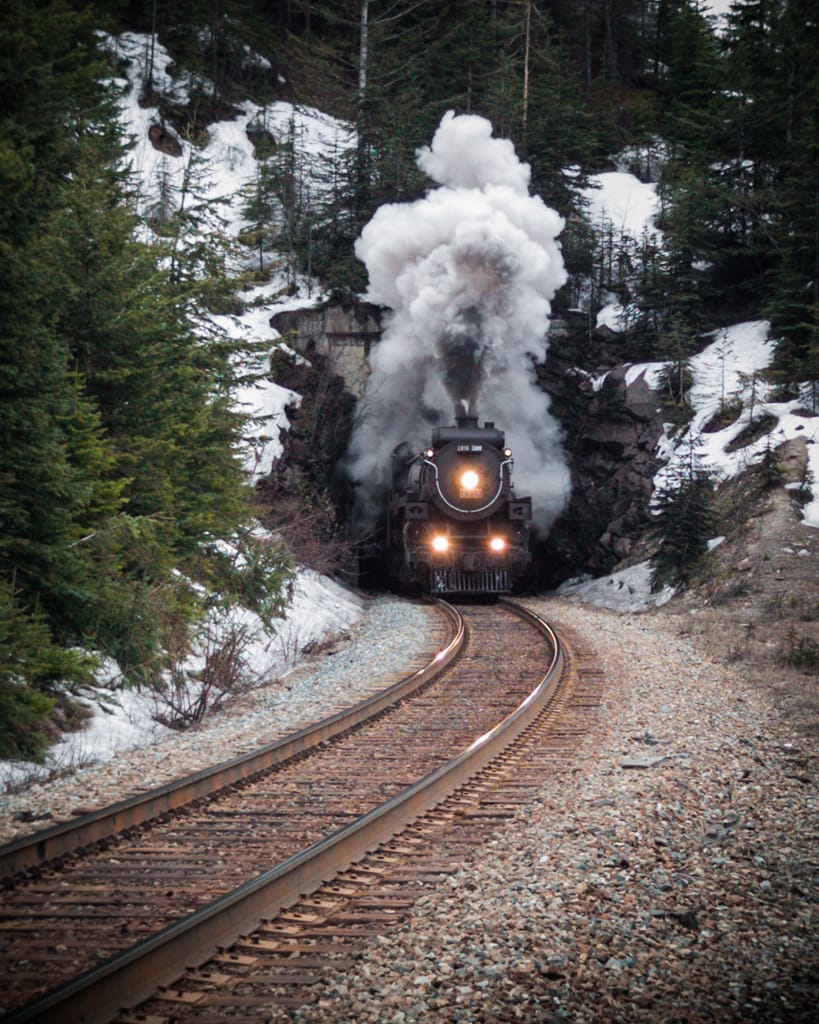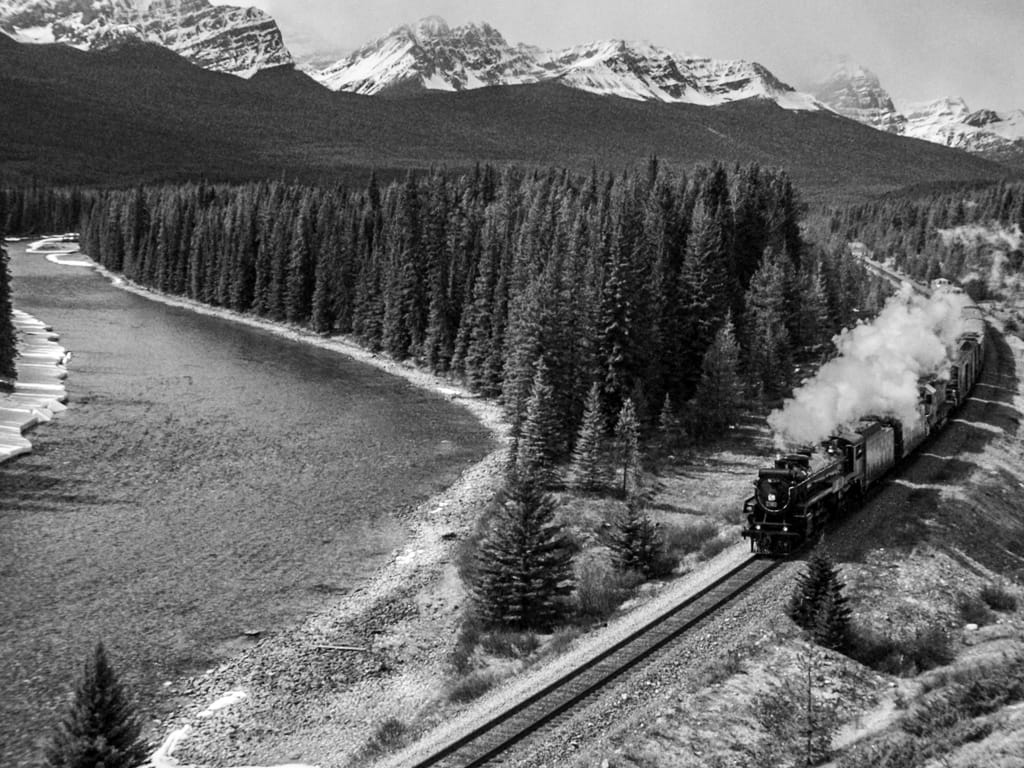Sometimes, I think I’m part dog. They chase cars. Me? I chase trains. I don’t know why.
Canadian Pacific is sending 2816 across Canada from Vancouver to Montreal in May this year, bringing along a load of very high-paying customers. The tour, arranged by a company in England, charged USD$25,000 per person for the experience. Supposedly, the trip sold out almost immediately. I can certainly understand why.
To prepare for this rather large excursion, 2816 has spent the large portion of the last six months undergoing a rather significant overhaul in Vancouver at the soon-to-be-demolished BC Rail Steam Shops. (Demolished because BC Rail is now under the control of the corporation formerly known as Canadian National Railways, and they have no need for steam shops in valuable rail yard property.) After a few tests, someone (not sure who, nor am I going to complain) felt a good shakedown run was needed.
A run out to Calgary.
As soon as the rail community catches wind of something like this, plans start swinging into shape. Although not publicized like the Inaugural Run, there was still a fair bit of information being distributed. It is safe to say that there will likely be more publicity behind the Trans-Canada Steam Express when it runs 10 May to 30 May. (With ticket prices like that, and the train itself as the showpiece, you can expect to hear about it.)
On Saturday, I decided I would chase from Golden to Calgary — a distance of about 260 km. I wouldn’t go all the way to Golden, since the canyon from just east of Golden for about 25 km is more-or-less useless for shooting. Instead, I started at the roadway that we used to go down for the Kootenay River Runners for whitewater rafting. We were just east of the area Canadian Pacific calls Palliser.
Now I know what you’re thinking. You’re thinking: “Geez, Geoff, you’ve already chased that thing twice before! Why do you want to do it again?” Simple: No two chases are the same. There’s always something different, and you always meet new people. Besides, it’s as good a reason as any to get out of the city for a few hours.
I was originally not going to travel alone — I had hoped Graham might come along. Unfortunately, Graham and his wife are preparing to move out of their condo, so he didn’t have time. He did offer me one bit of advice: get a shot at Ottertail. I knew of the place called Ottertail, but admittedly had no idea where it was. By description, I had thought I’d have seen at least a sign for Ottertail Creek. As it stands, I ended up in Palliser, giving up on finding Ottertail to the west.
A good 40 minutes early before 2816 would even depart from Golden, I took the opportunity to take in the majesty of the Rocky Mountains in spring. It was about two degrees, but the chill was stayed by a bright sun. When the nearby Trans-Canada Highway wasn’t carrying vehicles past, you could hear the wind whistling through the conifer needs, a small babbling brook, birds of several varieties, and the distant rumble of east-bound freight trains.
Unlike the last time, CP wasn’t about to shut down the Mountain and Laggan subdivisions just so The Empress would have an easy go of its route. The freight still had to go through. A lumbering eastbound popped into view about 20 minutes after I first heard it, blatting its horn as it approached the crossing. This gave me a chance to take a test photo of the angle I had wanted. Assuming 2816 arrived before it was too late, the sunlight would be good.
Not long afterwards, a CP Police truck rolled down the logging road from the highway. This was my first sign that I had for certain not missed 2816. The officer told me that there was a video crew shooting HDTV for the History Channel, or some such thing, and that they’d probably want to set up around where I was standing at the time. I thanked the officer for the information and let him know that I’d keep it in mind. With that, he bade me a good day, and rolled off to wherever he needed to be next.
A lot of people give railway police a lot of grief. They think of them as “near cops” rather than the full thing. Most people don’t realize that railway police have the same authority as regular police within 500 metres of railway property. That means for (at minimum) a kilometre-wide swath of land running across several parts of the country, a railway police officer can arrest and charge you with a criminal offense, the same as the RCMP.
Most of them, for the record, are nice people. A few throw the odd ‘tude, and a couple are a tad on the racist side (particularly east of Calgary, near the First Nations reservations). But treat the police with respect and don’t try to be an idiot, and generally they’ll treat you the same. I haven’t had any negative experiences with railway cops — just tell them what you’re doing, and they’ll let you keep doing it. (Unless it’s illegal, of course.)
Before long, I was no longer the only person at the crossing. An elderly gentleman, who knew some of the Rocky Mountain Rail Society members (he had received news of the schedule from them), and his wife took up station by the crossing. The man set up his camera a bit down the track, and the woman stayed in the truck to relay information from the radio chatter. (I need to get myself a scanner one of these days.)
By the time 2816 could be heard chugging up the hill, I had joined the older man on the south side of the tracks — the sun had risen far enough that my north vantage was decidedly poorer than it had been earlier. Over the loaded chuffing was the distinctive whine of an SD40-2, #6067 (in desperate need of a new paint job, I might add) following right behind the two tenders. CPR 2816 is a powerful locomotive, but doesn’t have the oomph needed to pull the train it carried over the Mountain and Laggan subdivisions, facilitating the need for the diesel. (The Empress now has MU controls, so it can operate the diesels directly, rather than having to have additional crew.)
On the train were CP 2816, its two tender cars, diesel locomotive SD40-2 6067, three tuscan red boxcars (including the much-needed tool car), the “Dominion” (buffet car), the “Smokie Smith” (recently renamed after a war hero), the “H.B. Bowen” (functioning as the CP crew car), and two California Zephyr Budd-built cars, the “Silver Lariat” and the bullet-nosed “Silver Solarium”. (The Zephyr cars are apparently for a hoity-toity excursion from Calgary to Vancouver, and were deadheaded with 2816 — though there were passengers on the cars from Golden to Calgary.)

As we were at a crossing, we got to hear the new whistle on 2816 as it approached. For some reason I have yet to learn, CP went out and acquired the whistle from 2-10-4 #5935, currently resting at the Canadian Railway Museum in St. Constant, Quebec. How they got it, I can’t even begin to imagine (aside from a large cash infusion into the non-profit’s coffers, anyway). Why they got it, I’m not sure. But I do have to say, it sounds nice. Different, though. I’m not yet decided if I like it or 2816’s previous whistle.
Leaving Palliser, I headed down the road to try and find my next spot. Finding 2816 having stopped not far away (the switches were full with two trains, and one had to move before 2816 could proceed), I blasted ahead to an overpass near the east end of Leanchoil. It would have been an ideal photo, the sunlight on a perfect angle, were it not for a westbound intermodal on the east track, blocking the view of the west track. Dejected, I continued east.
I spotted a crossing not far from the stop, spied easily by all the cars parked at the side of the road, and people milling around. I quickly pulled in and tried to find a good spot to take the photo. Although the track itself bended nicely, there wasn’t any suitable high ground from which to get a good shot. I had to settle for something mildly interesting. As 2816 rolled past, I waved at the passengers in the cars, as I had done at Palliser. And then I spotted her — my friend Terri was on board, about halfway down Dominion, waving back. She knew I was big on the chase.
At an unnamed bend a few miles away, I found several people camped out at the side of the highway. It looked like a decent area, and thought this might be the infamous Ottertail. It wasn’t. Still, I stuck around for a photo, and chatted with the other chasers while waiting for the train. It soon whistled its way around a bend, and shutters flew open and shut. Then it was back in the car and off to the next point.
On the way west, I’d seen a small bridge that I thought might be Ottertail. The only person there was having difficulty setting up his shot. He didn’t know what the area was called, but it wasn’t Ottertail. It was also a lousy shot due to so many trees between the ridge and the bridge. Five minutes and a few sticks of dynamite would have done wonders for photography…
Driving further east, I came across a large number of cars parked at the sides of the highway. Simple rule when you’re chasing trains: if there are a lot of cars parked at the side of the road, chances are there are a lot of people who know what the angle there is like. I scampered out of my car, scooted across the highway and hopped the concrete barrier. I hiked over to a creek valley where the people were standing, to find that I had arrived at the mythical Ottertail. It’s a beautiful area to shoot, despite a couple of poorly-placed trees.
As I took up my position, I glanced around to see who else I recognized from the previous stops. One of them I did a double-take on, because suddenly, I realized that I knew the person.
“Geoff?”
It was Mel, the photographer from McKinley Masters. He and I have been working on the McKinley Masters website, improving the content with more pictures. I hadn’t realized that Mel chased trains, too. It was something else we had in common. We didn’t get a chance to talk, though — it wasn’t long before 2816 came barrelling through.

Focus. Click. Snap. Run. Drive.
A few of us staged ourselves at the bridge over the CPR at the west end of the Field yard. One even got up the gumption to go down to the ground level and shoot from there (the elderly man I had met at Palliser, who was still with the rest of us, had suggested the same).
The train needed to stop at Field to get batteries for the passenger cars. (Apparently one of them had died.) This gave the photographers a chance to get some up-close shots of the train, and the video crew to readjust their camera on the front of the locomotive.
I left long before the train did and headed up to Cathedral, where a short tunnel covers the eastward rise up the Kicking Horse Pass. It’s a great place to get a few shots. I wasn’t the first to arrive, and I wasn’t the last. We probably had about 25 people up there at the high point, including a few CP employees (notably The Empress’ runahead crew, and the manager for the Royal Canadian Pacific passenger train), and the video crew. We had a while to wait.
It was cold. Barely above zero, and really windy. There’s not a lot of cover up there, either. The videographer stood out in a button-up shirt for the better part of 30 minutes before sending his partner back for his jacket. It even snowed a bit while we waited. It wasn’t as cold as when I chased 6060 back in 2001, but it was still uncomfortable.
Originally, 2816 was to meet the Royal Canadian Pacific (heading out to Vancouver for some big-name excursion) at Cathedral, where a siding allows two trains to pass on the mountain. Owing to a bit of a delay in Field, we were treated to a runby of the RCP on it’s way west. Led by 1401 (1400 apparently is in the shop), we found the errant 3084, which normally rides behind the Empress. We photographers would have far preferred 3084 to 6067, but then we weren’t the ones forking out for paying customers.
The Empress soon chugged up the mountain, belching huge clouds of smoke as it struggled with the weight behind it. You could hear the whine of 6067 kicking in when it was needed, and dying down when the grade eased up a bit. The hoggers on 2816 like to make her work whenever possible — most hoggers do in general — so killed the diesel as much as they could get away with.

I stopped at the Spiral Tunnel lookout, despite the parking area being closed, and snapped off a couple of photos before continuing to the summit. There, I found a pair of CP employees (both chasing the train) who had climbed up the side of a fair steep hill to get a good vantage. The light was lousy, but I tried it anyway.
On the east side of the pass, west of Lake Louise, I found my little bridge again to take some more pictures. It was only myself and a pair of men with their children. We almost didn’t hear 2816 coming — it’s all downhill to Lake Louise, and neither locomotives were under any load at all. They sailed right through, the linkages clanking on 2816, followed by the hum of the diesel.
I bypassed Lake Louise completely, opting for Morant’s Curve instead. The last time I was at Morant’s Curve was for 2816’s inaugural run, it was about one degree and early in the morning. This time, it was a bit warmer (about six degrees) and well into afternoon. The light wasn’t going to be great, but unless 2816 ran from the first thing in the morning, the light would never be ideal.
The video crew arrived just as 2816 made its approach to the curve. I have no idea if they even got anything useable on film. After that, it was a harrowing race east along Highway 1A (average speed: 90 km/h, including all the hairpins; average speed limit: 60 km/h) just to keep up. I caught shots at mile 100, shot through Banff to just east of Canmore (I was the only one there), the Highway 1X bridge east of Exshaw, and finally back to Calgary.

I laid in wait at Edworthy Park, where the CP line runs through into town. I had hoped for a better setting, but the leaves aren’t out fully, so I had a bit of a more dismal backdrop. My camera battery also decided to give me trouble, and I missed the nose shot, and had to settle for a departing view.
Didn’t matter, though. I had what I wanted: a full day of running through the mountains, following a hot hunk of iron on wheels. I still think I’m quite insane for this bizarre little hobby of mine, and I certainly can’t explain why I do it, but I love it all the same.
